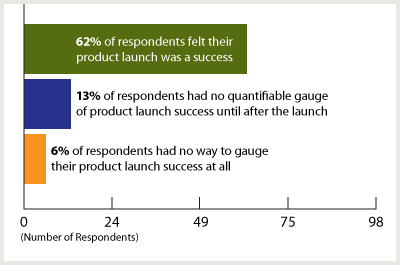A Critical Post-Launch Follow Up For Your New Product

Source: The Center for Business Innovation at Babson College
A recent survey from the Center for Business Innovation at Babson College showed that only 62% of respondents felt their product launch was a success. 13% even said they had no quantifiable gauge of performance until post-launch, and worse yet, another 6% said they had no gauge at all.
It would be madness to launch a new product without the proper planning and strategy, and the same would be the case for not conducting a post-launch follow up. Remember, it’s not good enough simply to get your product to the market. With all the resources your business has spent on the launch process, its ongoing success is crucial for the long term health of your company. Here are 5 questions you should ask yourself post-launch:
-
Did your product come out when you said it would?
There are any number of reasons that can delay a launch: from development, to manufacturing, to financial constraints. If there was something that sidelined your product, you need to find out how that impacted its sales. Also, you need to determine if this hurt your reputation as a company. Was there bad publicity or consumer backlash? Getting to the bottom of why these problems happened is critical information when moving forward with subsequent launches.
-
Was the timing right?
A lot of companies don’t understand (or even care to understand) how to time the release of a new product. Sometimes they’ll put it out in market even though there may be no demand. They might be trying to time the product’s launch with some other event, or feel that because the competition just launched their item, they need a similar response. These are not the reasons you should use when determining your timetable.
There’s also a real danger when it comes to releasing a product that features technology that might be too cutting edge. Did consumers struggle with adopting the technology behind your product? The other side of this issue is that if your item spent a significant amount of time in development, the market may have moved past its usefulness. You could find resistance on the part of consumers to purchasing a product that is already out of date when it hits the market.
-

The Volt was launched amid a huge push for electric vehicles.
But since then conusmer adoption has been fairly lukewarm.How did the market respond?
Part of your post-launch strategy should include how the market reacted to your new item or service. Was it positive, negative or just lukewarm? For example, the Chevrolet Volt was launched with a massive amount of fanfare by General Motors in December of 2010. While initial reviews by members of the media and other industry pundits were positive, the car still fell short of its 10,000 unit 2011 projected sales by around 3,800.
It’s very important that you take a look at reasons your target audience might have had to not buy from you. Talk to your customers and find out exactly what kept them from making a purchase. This information may help you change the current perception of your product.
On the flip side, you need to know why new customers purchased your item. What need did it fulfill for them? Was it because of price or because of the features that your item provided? It’s also critical to get feedback from customers about their experience with the product itself. Get reviews or testimonials by means of surveys so that you can get honest and objective information.
-
How did your sales force react?
Sales is a great place to gather important information regarding response to your product. When conducting your post-launch follow up, there are several key areas you should be evaluating:
- Feedback– Survey members of your sales team for their impressions of the how the product was received. Also find out what they thought of your pre and post-launch plans.
- Promotional Literature and Training Materials– Were the sales support items ready and useful for your staff? Did they provide adequate information about the product in a way that made sense and was easy to understand?
- Marketing Materials– How effective did your sales staff feel your marketing efforts were? Did they result in motivating your target market to make purchases? Was your unique value proposition communicated to your prospects and did it work?
- Feedback from Customers – Ask sales what the reaction of customers was to your new product. Were there any unforeseen problems that sprang up? Did customers use your product in ways that you might not have originally intended?
-
Were your customer support channels in place for launch?
Time and again, products fail in the market because behind the scenes support was not in ready or properly established prior to launch. Ask yourself the following questions in your post-launch follow up:
- Were customer service reps properly educated about the product so that they could effectively answer consumer questions about the product?
- Were customer service reps familiar with your company’s ordering and billing systems so that they could take orders?
- Could consumers quickly and easily find and purchase the product?
- Were products delivered in a timely fashion?
Conclusion
These questions should help you to form the basis for the post-launch review of your new product. Depending on your business model and item, you’ll want to sit down and figure out if there is any other information that might be helpful to you. Also, analyze how your launch goals lined up with reality and how you can learn from that information for next time. Remember that for the best results, you’ll want to set up surefire systems for capturing post-launch data in advance. That way it’s even easier, and more effective, to determine just how successful your product launch really was.
Posted in Marketing, Product Launch Marketing
Don`t neglect your friends, share this right away.





Leave a Reply